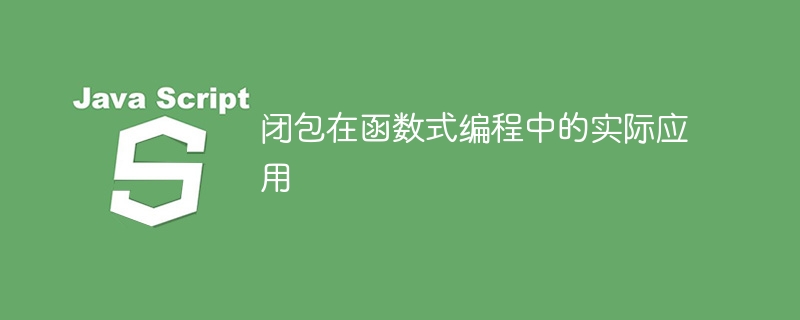Home >Web Front-end >JS Tutorial >Practical uses of closures in functional programming
Practical uses of closures in functional programming
- WBOYWBOYWBOYWBOYWBOYWBOYWBOYWBOYWBOYWBOYWBOYWBOYWBOriginal
- 2024-01-13 15:15:06630browse

The practical application of closures in functional programming requires specific code examples
Introduction
Closures are an important part of functional programming Concept, it means that in a nested function, the inner function can access the variables of the outer function. Closures have a wide range of practical applications in functional programming, making the code more concise and flexible, and enabling some advanced functions. This article will introduce the concept of closure and its practical application in functional programming in detail, and provide corresponding code examples.
Definition of closure
A closure refers to a situation where the variables of an external function can be accessed from within a function and can be called from outside the function. In functional programming, closures can be implemented through function nesting, where variables from the outer function are referenced within the inner function.
Practical application of closure
1. Delayed calculation
A common application is to implement delayed calculation. Using closures, we can defer some calculation operations until the function is called. The following is a simple example:
def multiply_by(n):
def multiplier(x):
return n * x
return multiplier
# 使用闭包创建一个乘法器
times_5 = multiply_by(5)
# 调用乘法器进行计算
result = times_5(10) # 输出50In this example, the multiply_by function returns an internal function multiplier, and the internal function can access the variables of the external functionn. The inner function returned by the outer function forms a closure and can be used in subsequent calls.
2. Counter
Closure can also be used to implement the function of a counter. Here is an example:
def counter():
count = 0
def increment():
nonlocal count
count += 1
return count
return increment
# 创建一个计数器
counter_1 = counter()
# 使用计数器
print(counter_1()) # 输出1
print(counter_1()) # 输出2In this example, the counter function defines a local variable count and returns an internal function increment. Each time the internal function is called, the counter will be incremented by 1 and the current count value will be returned.
3. Cache
Closure can also be used to implement the cache function. Here is an example:
def memoize(func):
cache = {}
def wrapper(*args):
if args not in cache:
cache[args] = func(*args)
return cache[args]
return wrapper
# 创建一个带缓存的函数
@memoize
def fibonacci(n):
if n <= 1:
return n
return fibonacci(n-1) + fibonacci(n-2)
# 调用带缓存的函数
print(fibonacci(10)) # 输出55
print(fibonacci(10)) # 不再计算,直接从缓存中取值,输出55In this example, the memoize function accepts a function as a parameter and returns an internal function wrapper. The internal function uses a dictionary cache to save the calculated results. Each time it is called, it first checks whether there is a corresponding result in the cache. If so, it returns directly. Otherwise, the result is calculated and cached.
Conclusion
Closures have a wide range of practical applications in functional programming and can be used to implement delayed calculations, counters, caches and other functions. By using closures, we can make the code more concise and flexible, and be able to implement some advanced functions. Through the specific code examples in this article, I hope it can help readers better understand the practical application of closures in functional programming.
The above is the detailed content of Practical uses of closures in functional programming. For more information, please follow other related articles on the PHP Chinese website!

